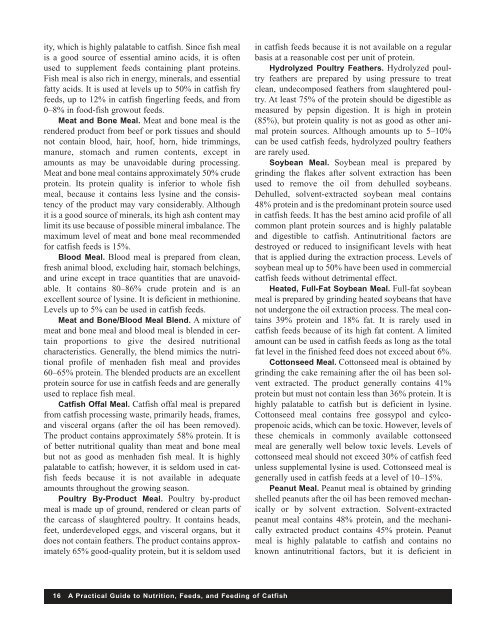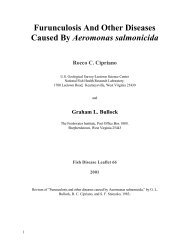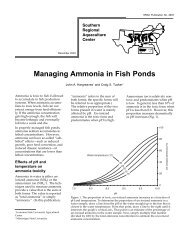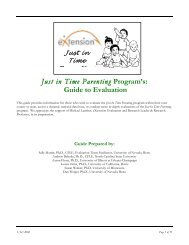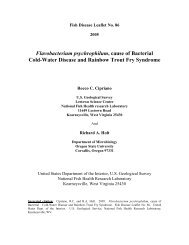A Practical Guide to Nutrition, Feeds, and ... - cop.eXtension.org
A Practical Guide to Nutrition, Feeds, and ... - cop.eXtension.org
A Practical Guide to Nutrition, Feeds, and ... - cop.eXtension.org
Create successful ePaper yourself
Turn your PDF publications into a flip-book with our unique Google optimized e-Paper software.
ity, which is highly palatable <strong>to</strong> catfish. Since fish meal<br />
is a good source of essential amino acids, it is often<br />
used <strong>to</strong> supplement feeds containing plant proteins.<br />
Fish meal is also rich in energy, minerals, <strong>and</strong> essential<br />
fatty acids. It is used at levels up <strong>to</strong> 50% in catfish fry<br />
feeds, up <strong>to</strong> 12% in catfish fingerling feeds, <strong>and</strong> from<br />
0–8% in food-fish growout feeds.<br />
Meat <strong>and</strong> Bone Meal. Meat <strong>and</strong> bone meal is the<br />
rendered product from beef or pork tissues <strong>and</strong> should<br />
not contain blood, hair, hoof, horn, hide trimmings,<br />
manure, s<strong>to</strong>mach <strong>and</strong> rumen contents, except in<br />
amounts as may be unavoidable during processing.<br />
Meat <strong>and</strong> bone meal contains approximately 50% crude<br />
protein. Its protein quality is inferior <strong>to</strong> whole fish<br />
meal, because it contains less lysine <strong>and</strong> the consistency<br />
of the product may vary considerably. Although<br />
it is a good source of minerals, its high ash content may<br />
limit its use because of possible mineral imbalance. The<br />
maximum level of meat <strong>and</strong> bone meal recommended<br />
for catfish feeds is 15%.<br />
Blood Meal. Blood meal is prepared from clean,<br />
fresh animal blood, excluding hair, s<strong>to</strong>mach belchings,<br />
<strong>and</strong> urine except in trace quantities that are unavoidable.<br />
It contains 80–86% crude protein <strong>and</strong> is an<br />
excellent source of lysine. It is deficient in methionine.<br />
Levels up <strong>to</strong> 5% can be used in catfish feeds.<br />
Meat <strong>and</strong> Bone/Blood Meal Blend. A mixture of<br />
meat <strong>and</strong> bone meal <strong>and</strong> blood meal is blended in certain<br />
proportions <strong>to</strong> give the desired nutritional<br />
characteristics. Generally, the blend mimics the nutritional<br />
profile of menhaden fish meal <strong>and</strong> provides<br />
60–65% protein. The blended products are an excellent<br />
protein source for use in catfish feeds <strong>and</strong> are generally<br />
used <strong>to</strong> replace fish meal.<br />
Catfish Offal Meal. Catfish offal meal is prepared<br />
from catfish processing waste, primarily heads, frames,<br />
<strong>and</strong> visceral <strong>org</strong>ans (after the oil has been removed).<br />
The product contains approximately 58% protein. It is<br />
of better nutritional quality than meat <strong>and</strong> bone meal<br />
but not as good as menhaden fish meal. It is highly<br />
palatable <strong>to</strong> catfish; however, it is seldom used in catfish<br />
feeds because it is not available in adequate<br />
amounts throughout the growing season.<br />
Poultry By-Product Meal. Poultry by-product<br />
meal is made up of ground, rendered or clean parts of<br />
the carcass of slaughtered poultry. It contains heads,<br />
feet, underdeveloped eggs, <strong>and</strong> visceral <strong>org</strong>ans, but it<br />
does not contain feathers. The product contains approximately<br />
65% good-quality protein, but it is seldom used<br />
16 A <strong>Practical</strong> <strong>Guide</strong> <strong>to</strong> <strong>Nutrition</strong>, <strong>Feeds</strong>, <strong>and</strong> Feeding of Catfish<br />
in catfish feeds because it is not available on a regular<br />
basis at a reasonable cost per unit of protein.<br />
Hydrolyzed Poultry Feathers. Hydrolyzed poultry<br />
feathers are prepared by using pressure <strong>to</strong> treat<br />
clean, undecomposed feathers from slaughtered poultry.<br />
At least 75% of the protein should be digestible as<br />
measured by pepsin digestion. It is high in protein<br />
(85%), but protein quality is not as good as other animal<br />
protein sources. Although amounts up <strong>to</strong> 5–10%<br />
can be used catfish feeds, hydrolyzed poultry feathers<br />
are rarely used.<br />
Soybean Meal. Soybean meal is prepared by<br />
grinding the flakes after solvent extraction has been<br />
used <strong>to</strong> remove the oil from dehulled soybeans.<br />
Dehulled, solvent-extracted soybean meal contains<br />
48% protein <strong>and</strong> is the predominant protein source used<br />
in catfish feeds. It has the best amino acid profile of all<br />
common plant protein sources <strong>and</strong> is highly palatable<br />
<strong>and</strong> digestible <strong>to</strong> catfish. Antinutritional fac<strong>to</strong>rs are<br />
destroyed or reduced <strong>to</strong> insignificant levels with heat<br />
that is applied during the extraction process. Levels of<br />
soybean meal up <strong>to</strong> 50% have been used in commercial<br />
catfish feeds without detrimental effect.<br />
Heated, Full-Fat Soybean Meal. Full-fat soybean<br />
meal is prepared by grinding heated soybeans that have<br />
not undergone the oil extraction process. The meal contains<br />
39% protein <strong>and</strong> 18% fat. It is rarely used in<br />
catfish feeds because of its high fat content. A limited<br />
amount can be used in catfish feeds as long as the <strong>to</strong>tal<br />
fat level in the finished feed does not exceed about 6%.<br />
Cot<strong>to</strong>nseed Meal. Cot<strong>to</strong>nseed meal is obtained by<br />
grinding the cake remaining after the oil has been solvent<br />
extracted. The product generally contains 41%<br />
protein but must not contain less than 36% protein. It is<br />
highly palatable <strong>to</strong> catfish but is deficient in lysine.<br />
Cot<strong>to</strong>nseed meal contains free gossypol <strong>and</strong> cyl<strong>cop</strong>ropenoic<br />
acids, which can be <strong>to</strong>xic. However, levels of<br />
these chemicals in commonly available cot<strong>to</strong>nseed<br />
meal are generally well below <strong>to</strong>xic levels. Levels of<br />
cot<strong>to</strong>nseed meal should not exceed 30% of catfish feed<br />
unless supplemental lysine is used. Cot<strong>to</strong>nseed meal is<br />
generally used in catfish feeds at a level of 10–15%.<br />
Peanut Meal. Peanut meal is obtained by grinding<br />
shelled peanuts after the oil has been removed mechanically<br />
or by solvent extraction. Solvent-extracted<br />
peanut meal contains 48% protein, <strong>and</strong> the mechanically<br />
extracted product contains 45% protein. Peanut<br />
meal is highly palatable <strong>to</strong> catfish <strong>and</strong> contains no<br />
known antinutritional fac<strong>to</strong>rs, but it is deficient in


